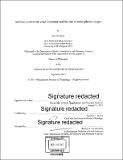Archean continental crust formation and the rise of atmospheric oxygen
Author(s)
Bauer, Ann M., Ph. D. Massachusetts Institute of Technology
DownloadFull printable version (43.92Mb)
Other Contributors
Massachusetts Institute of Technology. Department of Earth, Atmospheric, and Planetary Sciences.
Advisor
Timothy L. Grove.
Terms of use
Metadata
Show full item recordAbstract
This thesis examines critical aspects of the terrestrial environment that have resulted in a habitable planetary surface: the establishment of the continental crust and the progressive rise of an oxygenated atmosphere. The volume of continental crust on the earliest Earth is a critical parameter for constraining the chemical evolution of major terrestrial reservoirs, and radiogenic isotope signatures document this varying geochemical character. Chapter 1 presents a Lu-Hf and U-Pb isotopic characterization of zircons from the 4.0-2.9 Ga Acasta Gneiss Complex (AGC) and documents the magmatic extraction history of this domain, including changes in source compositions. These results are compared with a complementary dataset obtained using solution methods in Chapter 2. The integration of these results demonstrates the utility of performing coupled solution- and laser-based analyses on the same zircon populations to parse out U-Pb and Lu-Hf systematics. Zircons from many of these orthogneisses exhibit isotopic complexity due to the combined effects of accumulated radiation damage and repeated metamorphic episodes. For this reason, it is best to subsample zircon grains to isolate domains of distinct age and isotopic composition. In order to obtain suitable precision for subsampled domains, it was necessary to develop analytical techniques (Chapter 3) suited to small-volume analysis of the U-Pb and Lu-Hf isotope systems in zircon (via both laser ablation and solution analysis). In contrast to the whole rock Nd isotopic record of the AGC, the zircon Hf isotopic record does not indicate that rocks within the AGC were derived from a strongly depleted mantle. In order to evaluate the polymetamorphic evolution of these rocks, in Chapter 4 1 present a combined U-Pb and Sm-Nd isotope and trace element study of MREE-rich accessory minerals. In Chapter 5, I investigate sedimentary pyrite formation pathways and the oxygenation history of the late Archean atmosphere using combined sulfur and iron isotope signals as recorded in distinct morphologies of pyrite. This work represents a critical step in deconstructing the pathways of S-MIF production, transfer and preservation in the sedimentary record. Collectively, these studies contribute to our understanding of the establishment and evolution of the early continental crust and an oxygenated atmosphere.
Description
Thesis: Ph. D., Massachusetts Institute of Technology, Department of Earth, Atmospheric, and Planetary Sciences, 2017. Page 376 blank. Cataloged from PDF version of thesis. Includes bibliographical references.
Date issued
2017Department
Massachusetts Institute of Technology. Department of Earth, Atmospheric, and Planetary SciencesPublisher
Massachusetts Institute of Technology
Keywords
Earth, Atmospheric, and Planetary Sciences.